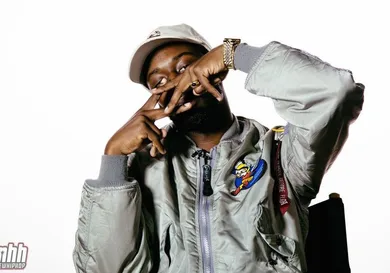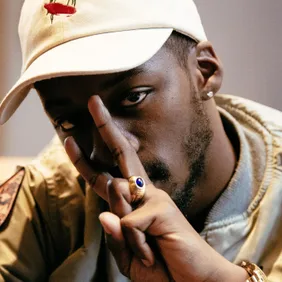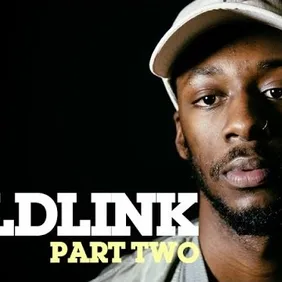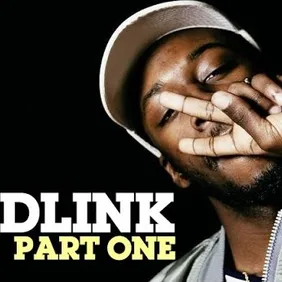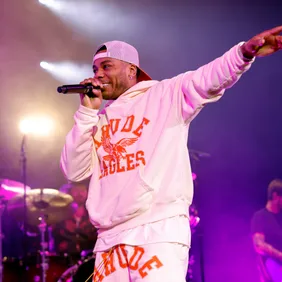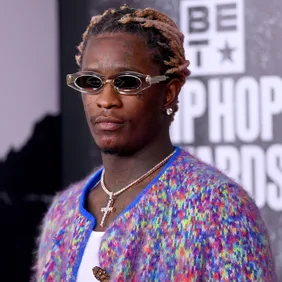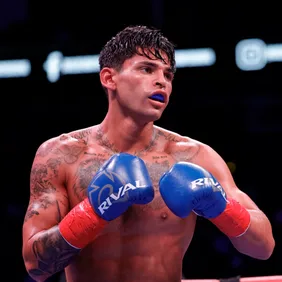Who/what is GoldLink? This is the question that led me, one evening earlier this year, to trek through sleet and bitter wind to MoMA PS1 in Queens, where GoldLink was performing in the giant geodesic igloo that stands in PS1’s courtyard. Like most of my fellow concert-goers, I had no idea what GoldLink looked like, or where he was from. Unlike most of his peers, GoldLink's social media presence was minimal. He appeared as sort of a reclusive, self-effacing SoundCloud will-o’-the-wisp who leveraged his internet mystique and singular musical sound in equal parts to build his passionate fanbase. In this way, each of these new followers was able to enjoy the sensation of having “discovered” him – stumbled upon his music by chance, its melding of GoldLink’s frenetic, staccato delivery and upbeat, shimmering, pulsating grooves. It is a style of music that sits at the intersection of hip hop and electronic music. Some call it “future bounce,” and GoldLink is its primary purveyor.
I remember little from the concert at PS1, aside from the tribal mask doing cartwheels on the projection screen behind GoldLink, and GoldLink’s distant silhouette basking in the orange and purple light and hitting the Fat Joe “Lean Back” dance ad infinitum at full throttle and exhorting the crowd to join him. The crowd obeyed, as the supply of energy in the PS1 igloo was nearly unlimited. The air was hot, humid, with nowhere to escape.
Many months later, after GoldLink releases his debut album And After That, We Didn’t Talk on November 6th, I meet with him in the HNHH office. He is hardcore slumped on the couch, as an astronaut might slump to the floor if he were to enter Jupiter’s gravitational field, resembling a slug more closely than the groovy man I saw at PS1. Though he eventually warms up and proves himself to be genial and humorous, GoldLink appears anything but at first.
This interview is perhaps antithetical to his entire aesthetic. Or maybe he is tired? It has been a whirlwind 18 months. GoldLink released his first project, a 9-track EP called The God Complex, in April 2014, shortly before his 21st birthday. That summer, he joined Flume and SBTRKT on their respective European tours, his first time ever traveling beyond the confines of the Washington, D.C. metropolitan area. In 2015, he headlined his first ever North American tour in 2015 and hit the road with Mac Miller for the “GO:OD AM” tour.
Despite the fact that he gained notoriety as a SoundCloud rapper, and not a DMV rapper, GoldLink is a deeply provincial artist. His experiences growing up in the DMV are the central source of his musical inspiration, and he doesn’t even feel truly comfortable unless he’s in the DMV, out on the town or at home with his two puppies, Guapo and Euri, in apartment, which is situated across the street from the studio. “Being away, I’m still never going to be good with that,” he says.
“I am 150 million percent completely connected to my region,” he explains earnestly. “The way that I talk, my slang, how I say things, how I go about things, my references, [they are all] very home-based. The bounce, the essence of what I’m trying to create, the stories that I’m trying to write. The way that we talk and the way that we interact with each other is just different. The way I dress, the way I carry myself, everything is from my region, because there’s nothing like it. You’ve never seen anything like it.”
Born D’Anthony Carlos in Northeast Washington D.C., GoldLink was initiated from a young age in the traditions of the DMV’s most native musical genre: go-go. “Go-go was literally the most influential thing we had growing up,” he says. He got his first taste of go-go as a toddler, when his father, a parks and recreation worker, would take him to neighborhood cookouts, where go-go would inevitably be blaring from the speakers – albeit the slower, late-‘60s/early-‘70s go-go of his parents’ generation, not the “fast and violent” style that he would grow to prefer.
After GoldLink’s parents split up, he moved with his mom from Cheverly, MD, to Bowie, MD, and then to Alexandria, VA for high school, where he proceeded to get involved in all manner of shenanigans that would inspire The God Complex -- chasing girls, indulging his hedonistic impulses, causing local havoc, "slangin' and bangin'" as he raps on "Zipporah." “Thinking that I was God," he says, "but I made mistakes and I didn’t care.”
GoldLink conceived AADWDT as sort of contextual prelude to the brash confidence he displayed on The God Complex. At the core of AADWDT kis GoldLink’s infatuation and ensuing romance with a girl named Zipporah, who shares a name with the biblical wife of Moses. “[In high school], I was the new kid,” he says. “And she was the new girl. And she was just so much FINER than every other girl. And I was just googly-eyed and shit. She was so pretty.”
A recurring theme in both project is the automobile -- The God Complex ends with a car crash, and AATWDT opens with a car crash as GoldLink leaves Ziporrah’s house. Cars, it seems, represent the urban sprawl of the DMV, and rapid movement, the excitement of being a teenager, and the irrational confidence, infinite potential, and recklessness one generally adopts when they first get their driver’s license. GoldLink is now 22, and the vitriol of his teenage years has, for the most part, subsided. He no longer drinks or does any sort of drugs. This change in temperament is the difference between The God Complex and AATWDT, the difference between anger and exploring the roots of that anger. “God Complex, I’m not that angry when I rap them joints live no more,” he says. “I was angry! I was hungry, I was mad as fuck. And I’m not mad, I’m rapping like a smooth R&B nigga now. Like I hit the bars, I’m just not as mad anymore.”
Click here to read part two.
GoldLink: Part 2
GoldLink had only been rapping for a few months in 2012 when he started to get involved in a non-profit youth program at Indie Media Lab, a DC-based studio run by his now-manager Henny Yegezu, and Yegezu’s studio engineer, Louie Lastic.
“The main goal was to get kids off the street and get them in the studio,” Lastic told me by email. “He was one of about 10 kids and definitely showed the most potential out of all of them.”
GoldLink has had the benefit of free studio time at Indie Media Lab ever since. In September, he had a month off between tours and decided to crank out an album. “[I was] like, ‘I’m just gonna make this album,’” he said. “Like ‘I’mma do this right now,’ and I did it.”
He would gather Lastic and a small squadron of homies and hunker down in the studio for days at time. Lastic served as the project’s executive producer. “Everything has to go through him,” Goldlink says. “So even if he doesn’t produce it, he has to adjust it and touch it and add something to it.”
Added Lastic: “We don't have a set routine for our studio sessions, there's a spontaneous aspect to our work flow that keeps things fresh. Sometimes he'll start writing to a skeleton of the beat and we'll flesh it out together, or sometimes he'll write to an almost completed track. It's different every time. We try and let the song dictate the work flow.”
Lastic and GoldLink benefited from the input of a third voice: legendary producer/music guru/oracle Rick Rubin, who first reached out to GoldLink last year via a Facebook message. In September, he invited the two of them out to his oceanside Malibu residence, known as ‘Shangri-La.’ In an “intimate room,” they sat there and played Rubin the album, and listened to his feedback. “Put a snare there,” GoldLink says, lifting a finger and imitating Rubin’s wise, raspy tenor.
Click here to read part three.
GoldLink: Part 3
At the heart of GoldLink's message is the belief that dance is intrinsically good. Dance as connection to others, Dance as self-expression, dance as salvation. Take for example the “Dance On Me" music video. Some hooligans have broken into a man's shop in the middle of the night, and the man calls his young employee (played by someone other than GoldLink -- he is never in his own videos) to break up the party. The young man bikes down there and finds a neon-lit dance party in full swing. Instead of breaking up the party, he succumbs to the power of dance. He dances, he dances some more, and in the end, he gets the girl. "Dance On Me:" a fairy tale, by GoldLink.
"I try to make undeniable music, period," he says. "I want everyone to dance again, I want everyone to have fun again, I want people to go to concerts and have people excited and not everyone being critics. Like honestly, my whole goal is for people to enjoy music again. Because I feel like music has kind of taken a dumbass turn in a lot of ways. But in the main way, people start to care about shit that I don’t. Maybe I’m weird. I feel like, my bigger goal is if everything just went back to the essence of the art, then I feel like honestly we’d be in a better world."
When GoldLink isn't making other people dance... what is he dancing to? “I dance to like Prince’s ‘Black Sweat,’” he says. “I get jiggy to some shit like that. That’s the type of music that no matter where you are, you take your shirt off, and just pour water all over yourself, and just dance.”
